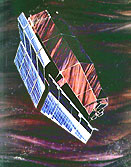|
|
The Einstein Observatory (HEAO-2)

The second of NASA’s three High Energy
Astrophysical Observatories, HEAO-2, renamed Einstein after launch, was the
first fully imaging X-ray telescope put into space. The few arcsecond angular
resolution, the field-of-view of tens of arcminutes, and a sensitivity several
100 times greater than any mission before it provided, for the first time,
the capability to image extended objects, diffuse emission, and to detect faint
sources. It was also the first X-ray NASA mission to have a Guest Observer
program.
Overall, it was a key mission in X-ray astronomy and its
scientific outcome completely changed the view of the X-ray sky.
Mission Characteristics
 Lifetime : 12
November 1978 - April 1981 Lifetime : 12
November 1978 - April 1981
 Energy Range :
0.2 - 20 keV Energy Range :
0.2 - 20 keV
 Special Features
:
First imaging X-ray telescope in space Special Features
:
First imaging X-ray telescope in space
 Payload : Payload :
- A Wolter Type I grazing incidence telescope (0.1-4 keV).
Four
instruments could be rotated, one at a time, into the focal plane:
- Imaging Proportional Counter (IPC; 0.4-4.0 keV)
eff. area 100 cm2, FOV 75´, ~1 arcmin spatial resolution.
- High Resolution Imager (HRI; 0.15-3.0 keV)
eff. area 5 - 20 cm2, FOV 25´, ~2 arcsec spatial resolution.
- Solid State Spectrometer (SSS; 0.5-4.5 keV)
eff. area 200 cm2, FOV 6´, E/delta E of 3-25
- Focal Plane Crystal Spectrometer (FPCS; 0.42-2.6 keV)
eff. area 0.1 - 1.0 cm2, FOV 6´, 1´x20´,
2´x20´, 3´x30´, E/delta E of 50-100 for E < 0.4
keV, E/delta E of 100-1000 for E > 0.4 keV
- Monitor Proportional Counter (MPC; 1.5-20 keV)
eff. area 667 cm2, FOV 1.5°, energy resolution ~20% at
6 keV. Co-aligned with the X-ray telescope.
- Objective Grating Spectrometer (OGS) : 500 mm-1 & 1000
mm-1, energy resolution dE/E ~ 50. Used in conjunction with
HRI.
 Science Highlights:
Science Highlights:
- First high resolution spectroscopy and morphological studies of
supernova remnants.
- Recognized that coronal emissions in normal stars are stronger
than expected.
- Resolved numerous X-ray sources in the Andromeda Galaxy and the
Magellanic Clouds.
- First study of the X-ray emitting gas in galaxies and clusters
of galaxies revealing cooling inflow and cluster evolution.
- Detected X-ray jets from Cen A and M87 aligned with radio
jets.
- First medium and Deep X-ray surveys
- Discovery of thousands of “serendipitous” sources
 Archive : HEASARC hosts Catalogs, Spectra, Lightcurves, Images and Raw data
Archive : HEASARC hosts Catalogs, Spectra, Lightcurves, Images and Raw data
[HEAO-2 Home]
[About HEAO-2]
[Archive]
[Software]
[Gallery]
[Publications]
[All Missions]
[by Time]
[by Energy]
Page authors: Lorella Angelini Jesse Allen
HEASARC Home |
Observatories |
Archive |
Calibration |
Software |
Tools |
Students/Teachers/Public
Last modified: Thursday, 24-Sep-2020 18:42:09 EDT
|


